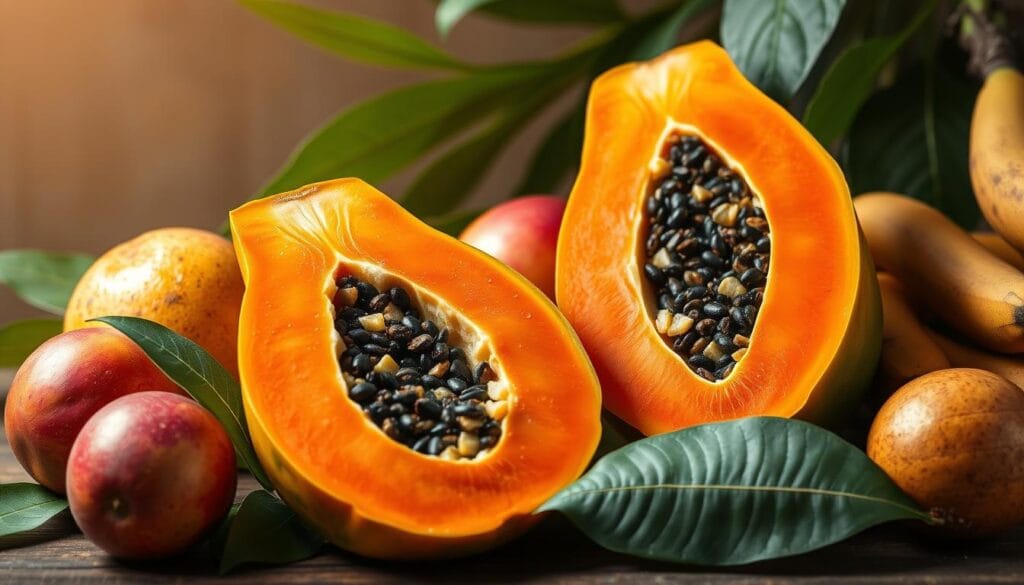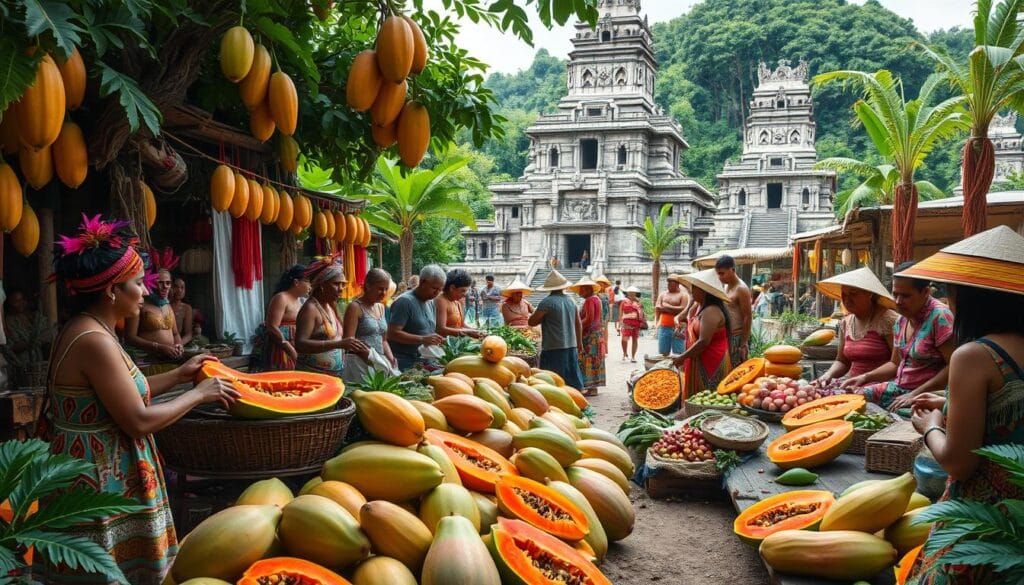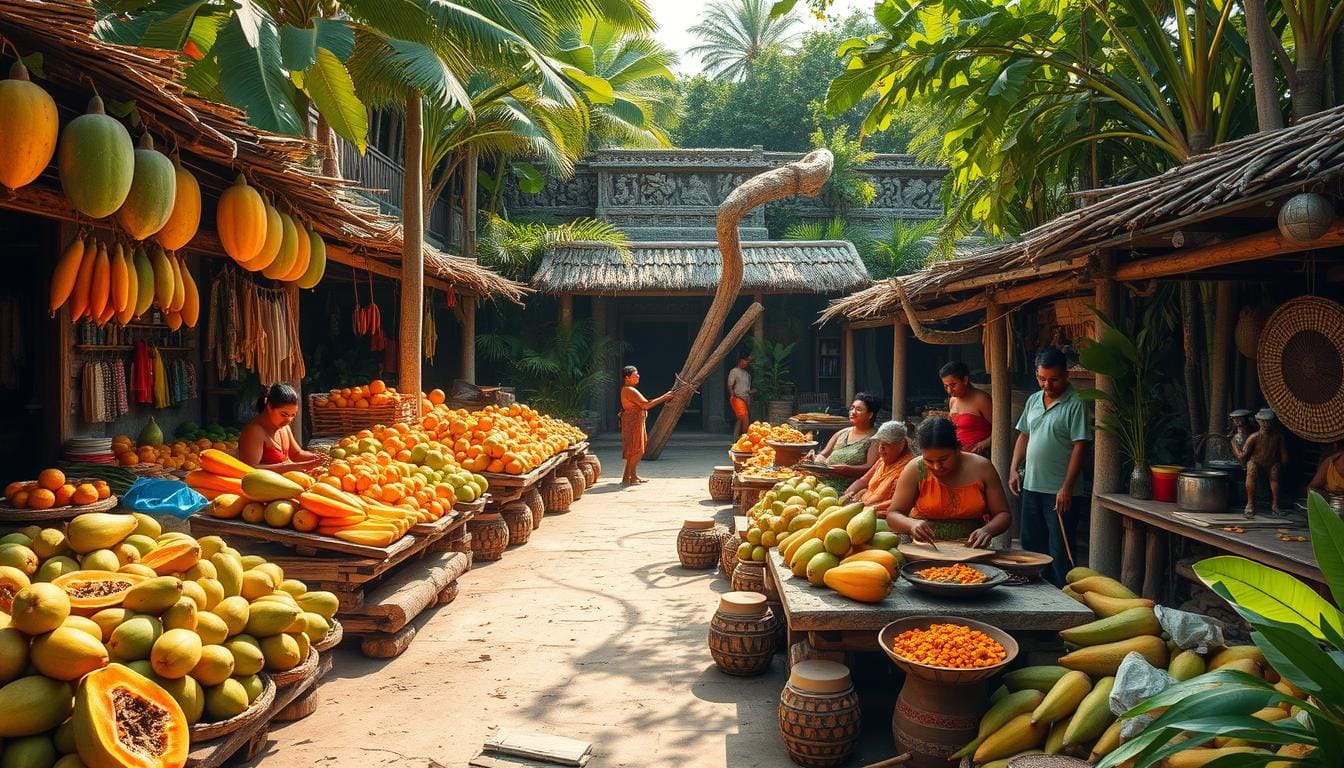The Mayans regarded papaya as the ‘Tree of Life,’ using it in various ways beyond mere consumption. Not only did they recognize its nutritional value, but they also understood its importance in their daily lives.
When exploring the Mayan uses of papaya, we notice their impressive skills in both healing and nourishment. For example, they created special pastes, highlighting their advanced medical knowledge long before modern treatments emerged.
Additionally, studies reveal that the Mayans began cultivating papaya around 4,000 years ago, marking a significant milestone in agricultural development. Moreover, their careful cultivation methods—removing weaker plants to retain only the strongest—demonstrate their sophisticated farming techniques and deep understanding of plant biology.
In conclusion, the Mayans incorporated papaya into every aspect of life. Whether as food, or a cultural symbol, papaya played an integral role, reflecting their profound connection to this remarkable fruit
The Historical Significance of Papaya in Mayan Culture
The Mayans were true masters at cultivating papaya, elevating its growth to an art form. More than just a crop, papaya played a significant role in their daily lives, deeply influencing their culture and medicine.
In fact, the Mayans referred to the papaya as the “Tree of Life,” a name that reflects its immense value to their society. This title underscores how essential papaya was—not only as a food source but also for its healing properties and spiritual significance
Overview of Mayan Agriculture
Mayan farming was advanced, with a focus on papaya. They used:
- Innovative slash-and-burn methods
- Smart crop rotation
- Choosing the best land
- Good land care
Role of Culinary Practices
Papaya was key in the Mayan diet. It was used in many dishes, adding nutrients and variety.
“The papaya was not just a fruit, but a cornerstone of Mayan nutritional understanding.” – Archaeological Research Studies
Nutritional Benefits of Papaya
Exploring papaya nutrition is like finding a treasure trove of benefits. This tropical fruit is full of essential nutrients that can change your diet. The Mayans knew about papaya’s value long before science did.

Papaya’s benefits go beyond its great taste. Let’s look at the amazing nutrients that make it a superfood.
Vitamin Powerhouse
Papaya is a vitamin powerhouse. One cup of papaya offers a lot:
- Approximately 62 calories per cup
- 15 grams of carbohydrates
- 2.5 grams of dietary fiber
- 11 grams of natural sugars
- Less than 1 gram of fat and protein
Vitamin C and Antioxidant Content
Papaya is high in vitamin C, with about 60 mg per 100 grams. That’s about 67% of what adults need daily. It also has a high antioxidant capacity, with an ORAC score of 1,753 µmol TE per 100 grams.
“Papaya is nature’s multivitamin, a complete nutrition package in one delicious fruit.” – Nutritional Research Institute
Culinary Applications of Papaya
Papaya played a central role in Mayan cuisine, offering a distinctive flavor and remarkable versatility. Beyond simply consuming it as a fruit, the Mayans discovered innovative ways to incorporate papaya into various dishes, enhancing both taste and nutrition. This rich culinary tradition has endured through time, continuing to inspire modern chefs who seek to blend ancient flavors with contemporary techniques
Traditional Mayan Dishes Featuring Papaya
Mayan papaya recipes show a wide range of dishes that highlight the fruit’s value. The Mayans saw papaya as more than just a food item. It was a vital part of their cooking.
- Raw papaya salads with wild herbs
- Papaya-based meat marinades
- Fermented papaya preserves
- Papaya-infused ceremonial beverages
Preparation Methods for Papaya
Papaya was incredibly versatile in Mayan cuisine. The chefs used various methods to bring out the fruit’s best:
| Preparation Method | Culinary Purpose |
|---|---|
| Raw Slicing | Fresh consumption and salads |
| Fermentation | Extended preservation and flavor enhancement |
| Meat Tenderizing | Enzymatic breakdown of protein fibers |
| Cooking | Warm dishes and ceremonial preparations |
“Papaya was not merely a fruit, but a sacred ingredient that connected the Mayan people to their agricultural roots and culinary traditions.”
Exploring these traditional dishes gives us a glimpse into the Mayan culinary world. Each method showed the Mayans’ deep respect and knowledge of papaya’s nutritional and flavor benefits.
Papaya’s Role in Rituals and Ceremonies
In the Mayan civilization, papaya symbolized life, fertility, and a spiritual connection to the natural world. More than just nourishment, it played a significant role in various rituals, representing vitality and completeness. Papaya was commonly used in ceremonies to honor nature, promote fertility, and support healing practices. Its unique qualities made it a sacred element in their spiritual traditions, reflecting the Mayans’ deep respect for the interconnectedness of life.
Symbolic Meaning of Papaya in Mayan Culture
The meaning of papaya went beyond its nutritional value. Mayans saw it as having deep spiritual significance:
- Representation of fertility and abundance
- Connection between earthly and spiritual realms
- Symbolic manifestation of life’s regenerative power
Ceremonial Significance
Papaya was vital in many ceremonies. Priests used it in rituals to connect with divine beings.
“The papaya fruit connects us to the spirits of our ancestors, bridging the physical and metaphysical worlds.” – Ancient Mayan Spiritual Text
Spiritual Interpretations
IIn Mayan ceremonies, papaya was more than just an offering—it served as a sacred link to the spiritual world. Its round shape symbolized completeness, while its vibrant color represented life and spiritual energy.
Papaya played a key role in various rituals, including:
- Agricultural blessing rituals: To ensure bountiful harvests and fertile lands.
- Fertility ceremonies: Celebrating its life-giving properties and connection to creation.
- Healing and purification practices: Used for spiritual cleansing and physical well-being.
Exploring papaya’s role reveals the rich spiritual world of the Mayans, where every natural element carried profound meaning and purpose.
Cultivation Techniques of Papaya
Mayan papaya farming reflects a world of deep knowledge and remarkable skill. Through years of experience and observation, the Mayans developed impressive techniques, clearly showcasing their profound understanding of nature and plant cultivation.
Papaya trees stand out in farming due to their unique characteristics. With the ability to bear fruit within a year and live for up to a decade, they offer both quick harvests and long-term productivity, making them an ideal crop for sustainable farming.
The Mayans’ methods highlight not just agricultural expertise but also their harmonious relationship with the environment, leaving a legacy of smart, sustainable farming practices.
Planting and Growing Conditions
To grow papaya successfully, farmers must carefully consider several key factors. First, selecting the right soil is essential; it should have good drainage to prevent waterlogging. Next, ensuring the plants receive ample sunlight is crucial for healthy growth. In addition, maintaining consistent soil moisture helps the plants thrive. Finally, shielding young plants from harsh weather conditions can protect them during their vulnerable stages.
By focusing on these essential steps, farmers can cultivate papaya crops that flourish and yield high-quality fruit.
Specialized Cultivation Practices
The Mayans had clever ways to grow papaya. They used:
- Planting other plants with papaya to improve soil
- Picking the best spots for plants
- Smart ways to manage water
*”The success of papaya cultivation lies in understanding the delicate balance between plant needs and environmental conditions.”*
Papaya’s quick growth cycle—producing fruit within a year—and its longevity of 5 to 10 years made it an ideal crop for Mayan farmers seeking fast and reliable yields.
Studying these techniques highlights the Mayans’ deep understanding of nature. Their skillful farming practices ensured both sustainability and productivity, leaving a lasting agricultural legacy.
Conservation and Sustainability
The Maya Forest is not only a shining example of sustainable papaya farming but also a testament to innovation. Spanning 54,000 km² across Belize, Guatemala, and Mexico, this vast ecosystem reflects the Mayans’ profound understanding of conservation.
Furthermore, sustainable papaya farming was more than mere agriculture for the Mayans; it represented a holistic approach to ecosystem management. Their methods demonstrated a remarkable balance between fulfilling human needs and safeguarding the natural environment.
Traditional Farming Methods
The Mayans had advanced farming techniques. They used methods that made the most of land while keeping the environment in balance:
- Forest gardening techniques prioritizing biodiversity
- Selective cultivation of economically valuable species
- Integrated crop management systems
- Minimal soil disruption strategies
Current Conservation Efforts
Today, the Mayans’ advanced conservation strategies continue to serve as a valuable source of inspiration for sustainable farming. As a result, researchers are increasingly turning to these ancient techniques in an effort to develop agricultural methods that not only respect natural ecosystems but also promote long-term environmental.
| Mayan Conservation Strategy | Modern Equivalent |
|---|---|
| Forest Garden Maintenance | Agroforestry Systems |
| Diverse Crop Cultivation | Permaculture Principles |
| Ecological Balance Preservation | Biodiversity Protection |
“The Maya understood that agriculture is not about conquering nature, but collaborating with it.” – Archaeological Research Insights
By learning from the Mayans, we gain valuable insights into sustainable farming, ecological balance, and the importance of working alongside nature. Their time-tested methods remind us that true agricultural success is achieved by nurturing the land, not exhausting it, ensuring that both nature and human communities thrive together.
Papaya and Economic Impact
Papaya was key in the Mayan economy, growing from a local crop to a major trade item. The Mayan papaya trade was more than just fruit exchange. It showed the Mayans’ skill in farming.

Trade and Economy in Ancient Mayan Civilization
Papaya was far more than a source of food for the Mayans—it was a valuable trade item that helped forge strong trade networks between communities. Its cultivation and exchange played a significant role in the economic development of the Mayan civilization.
| Economic Aspect | Papaya Contribution |
|---|---|
| Agricultural Productivity | Rapid fruit production (18 months) |
| Nutritional Value | Rich in vitamin C, papain, polyphenols |
| Trade Potencial | Versatile fruit with multiple uses |
Modern Economic Relevance
The tradition of growing papaya continues today, with modern farmers recognizing its value due to its numerous benefits and diverse uses. Papaya remains a key crop in agriculture, contributing to local economies and supporting global trade.
Papaya: From ancient Mayan trade routes to global agricultural markets, a fruit that has stood the test of time.
Understanding papaya’s past helps us appreciate its present impact and offers insights into how sustainable farming can continue to benefit both economies and communities worldwide.
The Influence of Papaya on Modern Cuisine
The Mayans’ rich culinary heritage continues to inspire chefs around the world. Papaya, once a staple in ancient Mayan cuisine, is now celebrated globally for its versatility.
While modern papaya recipes have evolved significantly from their traditional roots, they still reflect the fruit’s historical importance. Today, chefs creatively incorporate papaya into a variety of dishes—from refreshing salads and tropical smoothies to gourmet desserts—blending ancient traditions with innovative culinary techniques.
Papaya’s journey from ancient Mayan kitchens to contemporary cuisine showcases its timeless appeal and adaptability.
Integration into Contemporary Recipes
Modern chefs are getting creative with papaya:
- Papaya salsa with grilled seafood
- Tropical smoothie bowls with fresh papaya
- Papaya-infused marinades for proteins
- Desserts that highlight the fruit’s natural sweetness
Fusion Dishes Inspired by Mayan Traditions
Papaya in global cuisine tells a rich story of culinary heritage, where ancient traditions meet modern creativity. Chefs around the world blend Mayan culinary wisdom with international flavors, creating dishes that honor its history while pushing boundaries.
“Papaya represents more than just a fruit – it’s a connection to our culinary ancestry” – Chef Maria Rodriguez
Papaya inspires chefs everywhere, from street food to fancy restaurants. It shows that Mayan cooking wisdom is as important today as it was centuries ago.
Comparative Analysis of Papaya Use Globally
Papaya is more than just a fruit from the Mayans; it has evolved into a global treasure with remarkable significance in both food and more. By exploring how different cultures incorporate papaya into their lives, we can truly appreciate its versatility.
In fact, papaya’s adaptability is impressive across many regions. For example, in Thailand, it takes center stage as som tam, a refreshing and tangy salad that is beloved by locals and tourists alike.
Meanwhile, in Nigeria, papaya—commonly known as “pawpaw”—plays a key role, thanks to its numerous benefits.
Additionally, in Brazil, papaya cultivation not only supports the livelihoods of farmers but also contributes significantly to the country’s economy.
Regional Papaya Traditions
Papaya is used in unique ways across different parts of the world. For instance, Brazil and India are among the largest papaya producers, generating significant revenue from their harvests. Meanwhile, Mexico stands out as the leading exporter of papaya, highlighting the fruit’s global economic value.
“Papaya represents more than a fruit—it’s a cultural bridge connecting diverse global traditions.” – Agricultural Anthropologist
Unique Cultural Perspectives
Every place has its own unique way of using papaya. For example, the Mayans incorporated it into rituals and spiritual practices, while in contrast, other cultures focus on consuming it and leveraging its economic value. By 2009, papaya’s global trade had grown significantly, reaching a value of nearly $200 million.
By understanding these diverse uses, we can better appreciate papaya’s remarkable journey—from ancient Mesoamerican gardens to modern kitchens and hospitals around the world.
Conclusion: The Legacy of Papaya in Mayan Culture
The Mayan papaya legacy shows us not only the power of sustainable farming but also the brilliance of their creativity. Moreover, it tells us how the Mayans incorporated papaya into many aspects of their daily lives. In addition to being a source of nourishment, papaya played a crucial role in their cultural practices.
Learning from the Mayans, we see a smart way to use resources. They used papaya for food, to make soil better, and in rituals. Today, scientists are studying these old ways to improve farming.
Lasting Influence and Insights
The Mayans demonstrated diverse and innovative techniques in papaya cultivation. For instance, they practiced intercropping, blending papaya with other crops to maintain soil. This ancient wisdom offers valuable lessons for modern sustainable farming practices, emphasizing the importance of biodiversity and soil preservation.
Future Perspectives on Papaya Usage
Looking to the future, the Mayan approach to papaya cultivation and utilization can serve as a guiding framework. As interest in sustainable agriculture and nutrition grows, we are likely to see a resurgence of their time-tested methods. Moreover, by delving deeper into Mayan knowledge, we may discover novel ways to harness the potential of papaya while honoring its rich historical legacy.
FAQ
Q: What agricultural techniques did the Mayans use to cultivate papaya?
A: The Mayans knew how to grow papaya well. They understood its needs and how to care for it. They even knew about the different sexes of papaya trees.
Q: Was papaya important in Mayan economic systems?
A: Yes, papaya was key in Mayan trade. It was more than just food or medicine. It was a valuable item in their economy.
Q: How did papaya feature in Mayan culinary traditions?
A: Papaya was used in many ways in Mayan cooking. It was eaten raw or used in recipes. It was a big part of their food culture.
Q: Did papaya have spiritual significance in Mayan culture?
A: Papaya was more than just a food item to the Mayans. It was seen as the “Tree of Life.” This suggests it was used in rituals and ceremonies, carrying deep cultural and spiritual meaning.
Q: How do modern papaya practices compare to Mayan techniques?
A: Today’s papaya farming and cooking come from Mayan traditions. Modern methods are inspired by the ancient ways. This shows the lasting impact of Mayan knowledge on farming and cooking.

